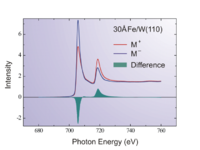X-ray magnetic circular dichroism

X-ray magnetic circular dichroism (XMCD) is a big name for a cool scientific trick. It helps us see the tiny magnetic fields of atoms and molecules!
Have you ever played with magnets? You probably know that magnets have a special force that pulls and pushes things. In atoms and molecules, there are tiny magnets too, but they are super small and you can't see them with your eyes. Scientists use special tools called synchrotrons to study these magnets.
The synchrotron sends special x-rays (kind of like super strong light) to the atoms and molecules. These x-rays have a special energy that helps us see the magnetic fields.
So, how does XMCD work? First, scientists choose a material they want to study, like iron. They put the material in the synchrotron and shine x-rays on it. Some of the x-rays hit the iron atoms and interact with their magnetic field. These x-rays bend and twist in certain ways.
The scientists then measure how the x-rays that passed through the iron are different from the x-rays that didn't hit the iron. They use a special computer program to analyze the differences and create a picture of the magnetic field.
With XMCD, scientists can learn more about how tiny magnets work and how they can be used in things like medicine or computer hard drives. It's like being a super spy, looking at things that are too small to see!
Have you ever played with magnets? You probably know that magnets have a special force that pulls and pushes things. In atoms and molecules, there are tiny magnets too, but they are super small and you can't see them with your eyes. Scientists use special tools called synchrotrons to study these magnets.
The synchrotron sends special x-rays (kind of like super strong light) to the atoms and molecules. These x-rays have a special energy that helps us see the magnetic fields.
So, how does XMCD work? First, scientists choose a material they want to study, like iron. They put the material in the synchrotron and shine x-rays on it. Some of the x-rays hit the iron atoms and interact with their magnetic field. These x-rays bend and twist in certain ways.
The scientists then measure how the x-rays that passed through the iron are different from the x-rays that didn't hit the iron. They use a special computer program to analyze the differences and create a picture of the magnetic field.
With XMCD, scientists can learn more about how tiny magnets work and how they can be used in things like medicine or computer hard drives. It's like being a super spy, looking at things that are too small to see!
Related topics others have asked about:
